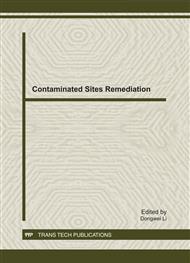p.27
p.32
p.39
p.45
p.51
p.56
p.63
p.68
p.76
Quantitative Evaluation of a Typical Petroleum Hydrocarbon Contaminated Site
Abstract:
Petroleum contamination in soil has become one of the important contamination issues. Aiming at large areas petroleum contamination in soil, this paper introduce risk assessment and contamination quantitative calculation method. Based on risk assessment model and related quantitative calculation method, select a specific petroleum contaminated site, conduct risk assessment for it and then calculated the volume of contaminated soils. As a research case, the study can provide guidance to the preliminary investigation and a basis for effective remediation.
Info:
Periodical:
Pages:
51-55
Citation:
Online since:
December 2011
Authors:
Price:
Сopyright:
© 2012 Trans Tech Publications Ltd. All Rights Reserved
Share:
Citation:


